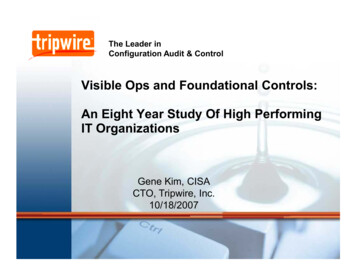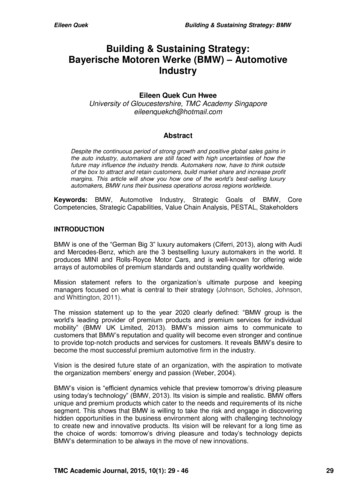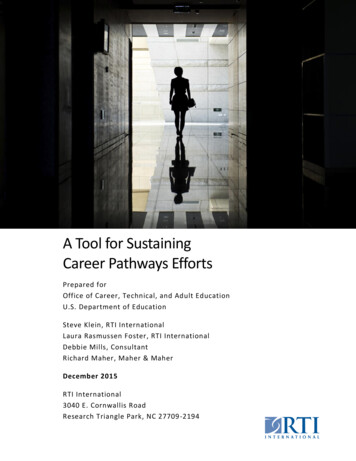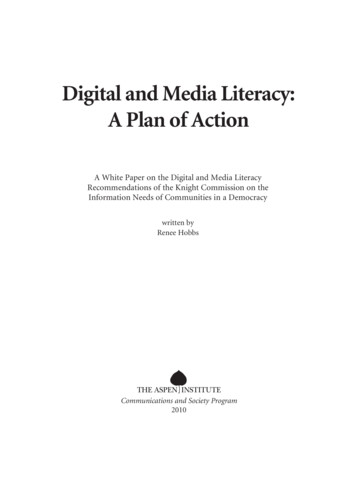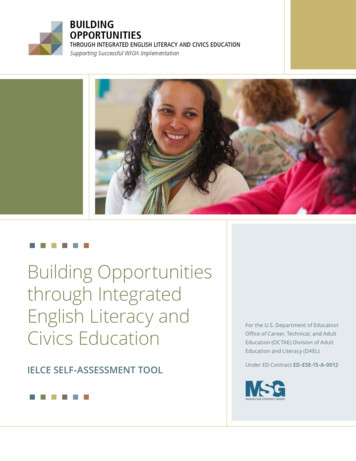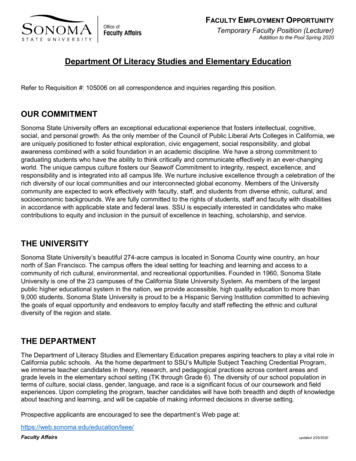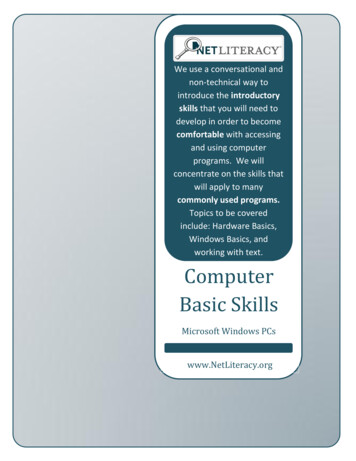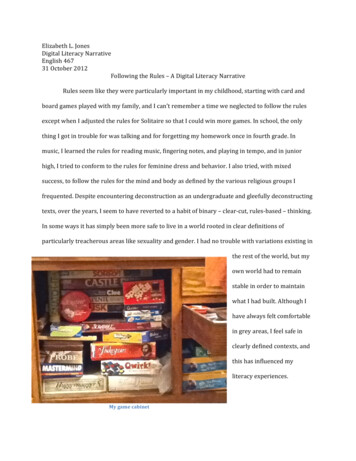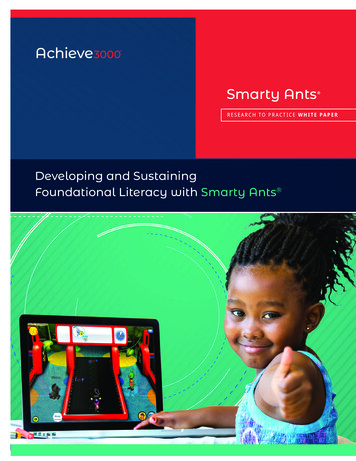
Transcription
R E S E A R C H TO P R AC T I C E W H I T E PA P E RDeveloping and SustainingFoundational Literacy with Smarty Ants
Developing and Sustaining Foundational Literacy Skills with Smarty AntsTable of ContentsSmarty Ants: A Solution for Foundational Literacy Success . 2Developmental Models of Reading. 3Building Basic Skills. 4Recognizing Letters and Letter Sounds. 4Phonemic Awareness and Phonics. 6Reading Words and Phrases. 8Fluency. 8Vocabulary. 8Reading Comprehension. 9Reading Words and Phrases.10Evaluating Aesthetics and Operational Elements of Smarty Ants.10Language Learners.10Conclusion.12References.132please call 1-800-838-8771 or visit achieve3000.com
Developing and Sustaining Foundational Literacy Skills with Smarty AntsSmarty Ants: A Solution for Foundational Literacy SuccessDespite historical and drawn-out debates on the best wayto teach children how to read English, very little debateexists about the specific skills children need to develop inorder to be successful readers today (Snow & Juel, 2005).In the landmark National Research Council publication,Preventing Reading Difficulties in Young Children, theCouncil emphasized that phonics activities and languageactivities that engage students with literary texts need tobe integrated in order to reach all students (Snow, Burns, &Griffin, 1998; National Institute of Child Health and HumanDevelopment [NICHD], 2000). The findings were supportedby the National Reading Panel (NICHD, 2000).software programs. However, many problems remainedwith how to determine the effectiveness of these softwareprograms (Sandholtz, Ringstaff, & Dwyer, 1997; Schofield,1995). More recently, a variety of ways have been proposedto evaluate such programs, including Bishop and Santoro’s(2006) nine-point framework for beginning reading softwarethat incorporates research from early reading educationand instructional technology. The added dimensions ofmotivation and aesthetics afforded by scrutinizing thecomputer interface and instructional design, in addition tobeginning reading content, provides a compelling, crossdisciplinary framework.Yet the context for the integration of comprehension andphonics activities into the literacy classroom has shifted – andcontinues to shift – as we move into an information-centeredeconomy where the literacy demands placed on childrenhave been rising. These demands, such as the ability to thinkcritically while reading, become more complex as childrenmove on to high school and into careers. Consequently,many young students are struggling to reach these newgoals established by the National Research Council andNational Reading Panel (Kamil, 2003; Snow & Biancarosa,2003; Snow, Griffin, & Burns, 2005). Estimates from theNational Assessment of Educational Progress (NAEP) placeonly one third of fourth graders in the United States at orabove the proficient level, leaving two thirds below proficientin reading tasks (National Center for Educational Statistics[NCES], 2011). This same level of proficiency holds truefor eighth graders (NCES, 2011), begging the questions:What more can be done to address the other two thirdswho struggle with reading? And how can their deficits beaddressed through early intervention?By blending elements from the National Research Council(Snow, et al., 1998), the National Reading Panel (NICHD,2000), and Bishop and Santoro’s frameworks (2006), thiswhite paper presents how Smarty Ants incorporates a rangeof research-based activities, practices, and games into aninteractive reading program. In addition, an explanation ofhow Smarty Ants may serve special populations, such asEnglish language learners and special education students,is offered.While many solutions have been proposed to address theperformance gap, the most effective approach has beento focus on early intervention for all readers to bolsterstudents’ knowledge of five fundamental componentsof reading: phonemic awareness, phonics, vocabulary,fluency, and reading comprehension (McCain & Mustard,1999; Snow, et al., 1998). Further, it is encouraged thatinterventions continue as needed for children (Snow &Biancarosa, 2003). As a result of these recommendationsfrom researchers, increased efforts to address children’sliteracy needs produced a proliferation of reading-basedSmarty Ants targets the needs of all struggling readers. Itsresearch-based curriculum and pedagogy were createdunder the advisement of a core team of educators fromStanford University and the University of California, Berkeley: Dr. P. David Pearson, world-renowned reading researcher,professor, and dean emeritus of the University of California,Berkeley, Graduate School of Education Dr. Robert Calfee, distinguished professor emeritus of theStanford University School of Education, and dean emeritusof the University of California, Riverside, Graduate Schoolof Education Dr. Mia Callahan, graduate of Stanford Universityand the University of California, Berkeley,and seasoned reading teacher of 30 years3please call 1-800-838-8771 or visit achieve3000.com
Developing and Sustaining Foundational Literacy Skills with Smarty AntsWhen designing the Smarty Ants program, the developers relied upon the findings of landmark intervention studies (e.g.,Foorman, Francis, Fletcher, Schatschneider, & Mehta, 1998; Vellutino et al., 1996; Vellutino, Scanlon, & Jaccard, 2003; Torgesen,et al., 1999) and the most influential reading studies of the past 50 years (e.g., Bond & Dykstra, 1967; Chall, 1967; Anderson,Hiebert, Scott, & Wilkinson, 1995; Adams, 1990; Snow et al., 1998; NICHD, 2000). Whether Smarty Ants is used with typicallydeveloping readers or at-risk readers, it provides a curriculum and pedagogy consistent with what top researchers havediscovered about how children learn to read.The end goal of all reading instruction is reading comprehension – the ability to make meaning from print. Without it, earlyreaders do not understand what they read, fail to read to learn, and ultimately struggle with literacy in their daily lives asadults. In order to understand the role that reading comprehension plays in later success, researchers have sought waysto model the reading process to understand where possible deficits or combinations of deficits in all stages of reading mayinhibit further development.Developmental Models of ReadingAfter extensive reviews of the extant research literature on reading, members of the National Research Council in theirreport, Preventing Reading Difficulties in Young Children (Snow, Burns, & Griffin, 1998), highlighted the specific points wherethe development of reading skills commonly break down, leading to difficulty comprehending text.By relying on high levels of scrutiny and empirical evidence, the report narrowed a broad range of reading-related concernsinto five categories: phonemic awareness, phonics, fluency, vocabulary, and reading comprehension. Building on theconclusions of the National Research Council, the National Reading Panel (NRP) report was published by the NICHD (NRP,2000). Both the National Research Council and the National Reading Panel reports made it clear that a comprehensiveapproach to reading instruction is necessary if all children are to become efficient and effective readers. The essentialcomponents include explicit, systematic instruction in phonemic awareness (a sub-category of phonological awareness),phonics, fluency, vocabulary development, and comprehension strategies. Throughout the subsections below, this literaturereview refers to this model of reading to explain how developers at Smarty Ants have incorporated relevant strategiesdocumented by scientific research into their software program.Reading, however, is not purely a cognitive function; it occurs along developmental and social lines. Developmentalpsychologists have highlighted other factors that affect a child’s success at reading tasks, including difficulty of the task itselfand motivation. Perhaps the most famous schema for understanding how a child’s development relates to his or her abilityto complete tasks is the “zone of proximal development,” a term coined by Lev Vygotsky (1978) to describe the zone where achild is optimally challenged to grow and learn with proper scaffolding. Thus, the zone of proximal development is the spacewhere a challenging developmental task is also potentially instructive.From the outset, Smarty Ants addresses the individual child’s zone of proximal development by assessing what the childknows through an interactive assessment. Moreover, computer-adaptive lessons are found throughout Smarty Ants, inwhich instruction and activities change based on the success of the student at playing games and answering questions.All of the lessons and games have consistent feedback throughout that encourages the child at his or her demonstratedlevel, based on current and prior successes with the program. It is evident that Smarty Ants meets or exceeds the criteriafor instructional technology programs referenced in Table 1.1 (Bishop and Santoro’s framework, 2006) for instructionaltechnology programs targeting early reading skills. Multiple opportunities to view progress are provided in all games, as wellas in the reward room, the ant home, and the ant store.4please call 1-800-838-8771 or visit achieve3000.com
Developing and Sustaining Foundational Literacy Skills with Smarty AntsBuilding Basic SkillsHigh-quality, technology-based interventions may help remedy early gaps in developing phonological awareness (Snow et al.,1998). Phonological awareness is the umbrella term, which primarily incorporates phonemic awareness and syllabification.For many students, excepting those with reading difficulties, phonological awareness comes from routine interaction withfamily members (Werker & Lalonde, 1988). Deficits in phonemic awareness are much more common, however. Phonemicawareness at its simplest is the ability to manipulate individual sounds in words. Phonics, on the other hand, is the teachingof how sounds relate to word spellings in systematic ways. Each of these will be further explained below with appropriateexamples from the software.RecognizingLetters and LetterSoundsFigure 1 – The Assessment Pool is where each child is initially assessed for placementin the appropriately leveled learning environment.Critical reviews of readingresearch, such as the oneconducted by MacArthur,Ferretti, Okolo, and Cavalier(2001), highlight howtechnology can potentiallyteach phonologicalawareness and decodingskills, especially now thatmany software programsteach letter-soundcorrespondences andallow for the manipulationof sounds in words. Thisis of critical importance,considering that one ofthe main stumbling blocksthat children experience indeveloping their readingabilities is based on thesimple concept thatwords are composedof both immutable andmalleable componentsthat, depending on theirarrangements, create new words. Lessons 3-69 in Smarty Ants have children watching and participating in the creation ofwords from sounds. This occurs concurrently with the teaching of sound-letter correspondences.5please call 1-800-838-8771 or visit achieve3000.com
Developing and Sustaining Foundational Literacy Skills with Smarty AntsTable 1.1 – An evaluation of Smarty Ants using Bishop and Santoro’s Framework for InstructionalSupport and Assessment (2006)CriterionInclusion in Smarty AntsInstructionally Supportive: The program provides content support when the learner needs it Yes The content support is helpful but not so prescriptive it short-circuits learning Yes The program uses informative and instantaneous feedback messages to supportcontent learning Yes The program branches automatically to accommodate the learner’s remediation needs YesAssessing: Yes, continuously The program saves learners’ work The program provides progress summaries Yes The program graphs or charts learner performance in an easily interpreted way Yes The program interprets learner performance and makes recommendations for howto proceed Yes The program includes an administrative function that tracks all learners workingwith the program YesSmarty Ants directly teaches letter-sound correspondencesthrough a variety of activities, including Four Square,Hoops, Treadmill, and other games. When children entera lesson, they watch a brief teaching video from the AntCoach. Children then have the option of playing a gamelike Treadmill, which as the name suggests, is based on theeponymous piece of gym equipment.On the Treadmill, emerging readers are asked to listen toletters called out to them, and then jump on those letters asthey move along the conveyor belt. When a letter has beenaccurately identified a specific number of times, the playerwins that letter and is directed to incorporate that letter intowords that are later used to build a story.If the child gets the letter wrong, he or she is providedassistance and instruction. The transition is seamless in thegames, as children then interact with the learning cloudvideos that teach the sounds of the letters, often involvingthe inflating of letter-shaped balloons.Figure 2 – An ant on the Treadmill learningletter-sound associations.6please call 1-800-838-8771 or visit achieve3000.com
Developing and Sustaining Foundational Literacy Skills with Smarty AntsActivities that accurately represent letter sounds, provide feedback for the child during the learning process, and includeprolonged engagement with the tasks, should produce results for children who are just building their letter-soundcorrespondence knowledge and mimic proven instructional tasks used in early childhood education (Cunningham, 2005).All of the activities in Smarty Ants provide this type of instruction.Phonemic Awareness and PhonicsIdentifying letters and their sounds are part of the picture of developing robust phonological awareness, but isolating theindividual sounds in particular words is even more important. Referred to as phonemic awareness, the ability to isolateindividual sounds represents the “metalinguistic understanding that spoken words can be decomposed into phonologicalprimitives, which in turn can be represented by alphabetic characters” (Pugh, Sandak, Frost, Moore, & Mencl, 2006, p. 65).Phonemic awareness is learned primarily in a classroom environment (Snow, Burns, & Griffin, 1998). Typically, the soundsof letters, as well as letter combinations such as digraphs, diphthongs, and blends, also are taught in school in the form ofphonics instruction.Figure 3 – Word bubbles illustrating blending phonemes to create words.In a Smarty Ants game such as Four Square, the childplaying the game will be given the opportunity to identifyletters. Then the letters’ relationship to a word, illustratedon the screen above, will be shown with each phonemeblended both aurally and visually. Through the use of soundand word bubbles, the child is able to “see” the sequentialblending of individual sounds merge together to form a word,while simultaneously hearing the sounds as they are blended.This technique corresponds to a popular instructionalstrategy called sound boxes. Sound boxes, like many otherstrategies used to isolate and manipulate phonemes inwords, emphasize the individual phonemes as well as theprocess of blending phonemes. Preliminary research hasshown that the systematic use of sound boxes or phonemicsegmentation has positive effects on developing phonemicawareness (McCarthy, 2008; Yeh & Connell, 2008).Another way that phonemic awareness is explicitly taughtin Smarty Ants is through the use of rhymes. Becausetraditional rhyming games require an understanding ofhow to manipulate sounds in words, they can be effectivein teaching simple manipulation of phonemes. Researchsuggests that, due to the complex nature of developinga tiered curriculum in many classrooms on phonemicawareness (McGee & Ukrainetz, 2009), computer-basedprograms may be one of the best ways of developingmastery in this area. Table 1.2 presents the aspects ofalphabetic understanding and phonological awareness thatare found in Smarty Ants.Phonological awareness is taught in combination withalphabetic understanding in Smarty Ants. While the Bishopand Santoro (2006) framework suggests that it is best tolearn phonemic awareness without letter representations,7please call 1-800-838-8771 or visit achieve3000.com
Developing and Sustaining Foundational Literacy Skills with Smarty Antsthe National Reading Panel Report (NICHD, 2000, p. 7) states that phonemic awareness instruction “is most effective whenchildren are taught to manipulate phonemes by using letters of the alphabet.” Furthermore, initial observations of childrenplaying Smarty Ants suggest that children spontaneously speak the sounds and words taught within the program. So whiletwo components of Bishop and Santoro’s (2006) framework are not addressed exactly as articulated, deeper observationsreveal that flaws may exist with the framework as designed.Table 1.2 – An evaluation of Smarty Ants using Bishop and Santoro’s Frameworkfor Alphabetic Understanding and Phonological Awareness (2006)CriterionInclusion in Smarty AntsAlphabetic Understanding: The program uses concrete representations for manipulating letters in the word Yes, with word bubbles The program requires learners to manipulate the letter-sound correspon-dencesin words Yes, in Rhyme Time & WordBuilding in each lesson The program develops learners’ skills at producing letter-sound correspon-dences inwords Yes, in Learning Clouds, WordBuilding, and Story BuildingPhonological Awareness: The program only uses concrete representations, not text for manipulating speechunits The program requires learners to manipulate targeted speech units auditorially The program develops learners’ skill at producing targeted speech units Both are included Yes Not explicitly. Smarty Antspilot research reveals tha
6 eeloin an Sustainin ounational iteracy Sills it Smarty Ants please call 1-800-838-8771 or visit achieve3000.com Criterion Inclusion in Smarty Ants Instructionally Supportive: The program provides content support when the learner needs it Yes The content support is helpful but not so prescriptive it short-circuits learning
